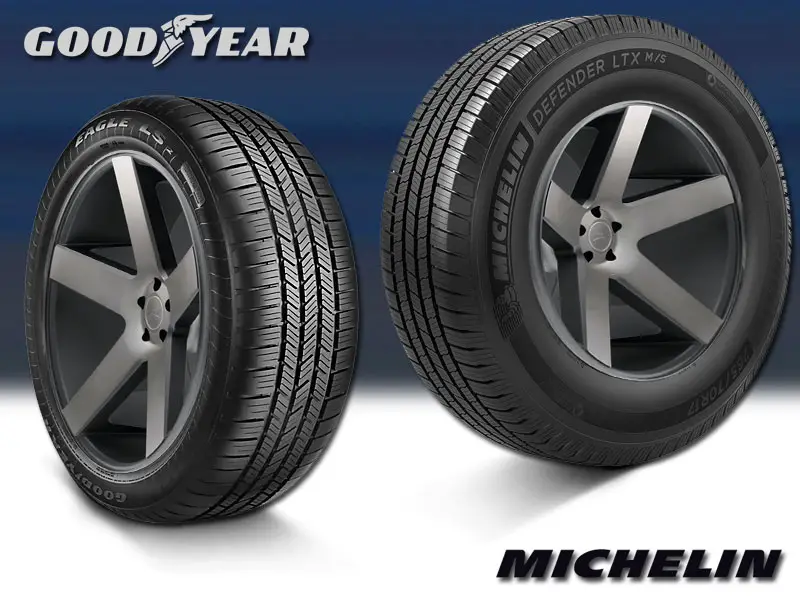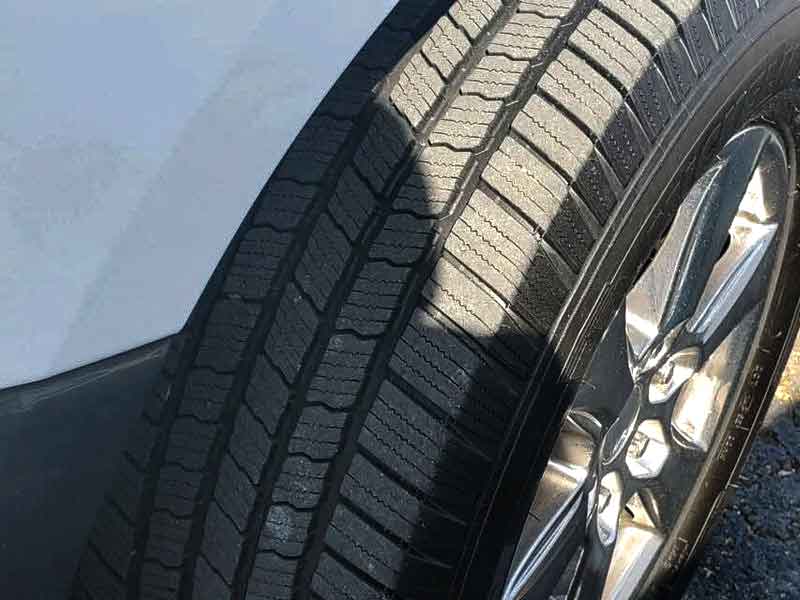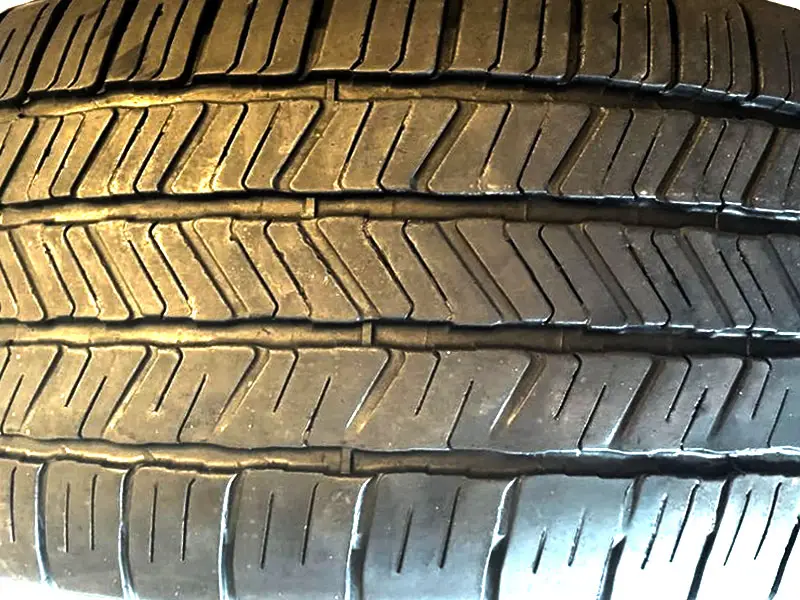Both are high-performance tires built for all seasons that provide higher braking capabilities, responsiveness, and extra cornering in different conditions.
However, when we compared them, we found out that the dry grip and handling of Michelin Defender is far more superior because of its narrower grooves and the closely positioned shoulder blocks. On the other hand, LS2 offers a better grip on wet and icy roads due to the numerous sipes found on the central part of its tread.

In addition to this, there are some other major differences between both the tires that we will cover in this article. So, let’s start!
Table of Contents
Side By Side Comparison
Michelin Defender LTX MS

Goodyear Eagle LS2

Supporting an asymmetrical design, Michelin Defender possesses two outward shoulders.

The shoulders and the central blocks are separated by narrow grooves found on the entire tread. Sipes found on the central blocks of the tread are less in number.
However, this is compensated by the numerous deep sipes available on the shoulder blocks. Furthermore, the shoulders are compact and the blocks are closely positioned.
This results in a major difference in the performance when it comes to the handling capabilities of the tire.

Just like its competitor, the Goodyear Eagle also possesses an asymmetrical tread design along with wide longitudinal grooves running around the entire tread. The sipes found on the central part are numerous and deeper. But, the shoulders of the tire are open and the blocks on the shoulders are also larger. As a result, its dry handling performance is not much effective.
Grip Comparison
Narrower grooves of Defender prove to be helpful in maintaining the tire’s grip on dry roads. That’s because the contact patch will increase and as a result, the braking distance will reduce. However, the same performance is not translated into this tire’s grip on wet and icy terrains. The sipes found on the centre of the tire are lesser in comparison. As a result, they do not prove to be much effective in maintaining the vehicle’s grip leading to reduced grip on these surfaces. But, when you take this tire on soft snow, its wide grooves prove to be a great helping hand in evacuating the soft snow and throwing it backwards. Due to this, its braking distance on soft snow is recorded shorter than its competitor.
Talking about the dry grip of Goodyear LS2, it possesses wider grooves as compared to its competitor. This results in a lower contact patch and a higher braking distance on dry surfaces. Therefore, its grip on dry roads is compromised. But surprisingly, its grip on wet and icy surfaces is incredible. The sipes present on the central part of the tread are deep and numerous. Therefore, the tire will engage well on these terrains and its braking distance will reduce. However, it struggles a bit on soft snow terrains. That’s because its comparatively narrower grooves are unable to evacuate the soft snow effectively. As a result, its braking distance on snow increases.
Handling Comparison
When it comes to the handling of both the tires, Michelin offers excellent handling on dry roads due to its incredible shoulder design. The compact shoulder design and the closely packed shoulder blocks help the tire to complete a lap much faster. As a result, the driver gets to enjoy spectacular handling on dry tracks. The same performance is translated into wet and ice handling as well. Even though the sipes on the central blocks of the tread are not that effective, this is compensated by the numerous and deep sipes found on the shoulders. Therefore, the time taken by the vehicle to complete a lap on wet road also reduces. However, when it comes to soft snow, the result is not as good as its counterpart due to its lower void ratio. The closed shoulder blocks do not allow productive evacuation of snow and as a result, the lap time of this tire is increased.
In comparison, the open shoulder design of Goodyear along with larger shoulder blocks reduces its handling performance on dry roads. The reason behind it is that the wide shoulders will decrease the contact patch. As a result, the vehicle will require more time to finish a lap on dry tracks. In addition to this, the sipes on the shoulder blocks are also ineffective and less in number. Thus, the drivers will get a lower wet handling speed as compared to its counterpart. But, this tire’s performance on soft snow is comparatively better due to its wide shoulders which decrease its lap time.
Comparison of Hydroplaning Resistance
When we compared the hydroplaning resistance, we found a huge difference in the performance of both tires. When it comes to Defender, there are more reported cases of hydroplaning as compared to LS2. The relatively narrower grooves of this tire do not prove to be much effective when it comes to maintaining its grip on flooded roads. Therefore, the vehicle is more likely to lose its grip and the probability of accidents will increase.
On the other hand, the grooves of Goodyear Eagle are much wider in comparison. In addition to this, the deeper sipes present on the shoulder blocks help the tire in wiping away the water from its grooves. Therefore, the vehicle will maintain contact with the road even on flooded roads.
Comparison of Rolling Resistance
The energy required by a tire to roll over a surface is known as rolling resistance. The higher the contact patch of the tire, the higher its rolling resistance will be. That’s because the tire will need more friction to roll over the surface. Here, Defender possesses narrower grooves. As a result, its contact patch will increase. The rolling resistance will also be higher due to the higher contact patch. So, the vehicle will require more fuel to maintain its motion on the road.
Comparatively, the contact patch of LS2 is lower. Therefore, its rolling resistance will be lower as well. Due to the lower rolling resistance of these tires, their fuel efficiency increases.
Comfort Comparison
The comfort level of Defender is excellent due to its narrower grooves. The tire does not offer much space for the air particles to be stuck inside its grooves. So, it will not produce much noise as compared to its rival and the drivers will get comfortable ride.
However, Goodyear Eagle will have a higher noise level. That’s because these tires possess wider grooves as compared to their competitor. As a result, the air particles will have more space to strike back and forth. Therefore, more noise will be produced.
Durability & Treadwear
Talking about the durability and treadwear of the tires, Defender will be more prone to wear and tear because of its weaker built and higher rolling resistance. The tires will also offer less mileage due to their lower durability. However, on the brighter side, there are thickened sidewalls and rim protectors. This will provide the tire with protection against scratches and punctures.
On the other hand, LS2 will have a longer tread life as compared to its competitor. That’s because these tires feature a lower contact patch. So, less area of their tread will come in contact with the road and it will wear out slower. In addition to this, these tires are made using carbon black and silica tread compounds. This is what adds more to their durability while driving on roads with high temperatures.
Summary
- Both are All-Season tires.
- The dry grip of Defender is superior and LS2’s grip on wet road and ice is more effective.
- The dry and wet handling of Defender is excellent.
- The hydroplaning resistivity of LS2 is better.
- Rolling resistance of Defender is higher leading to lower fuel efficiency.
- Goodyear will have a higher noise level due to its wider grooves.
- The tread of LS2 is likely to wear out slower because of its lower rolling resistance.
- Defender is a lower-priced tire.


